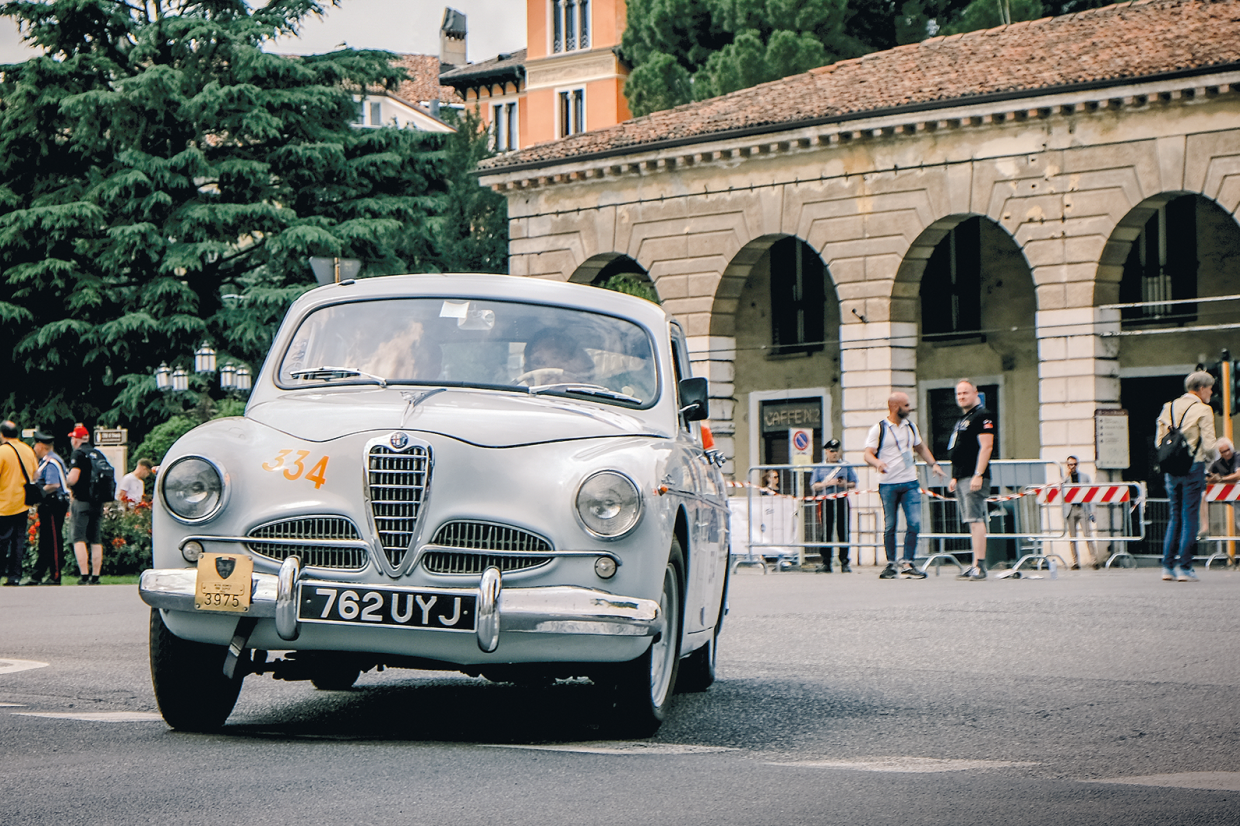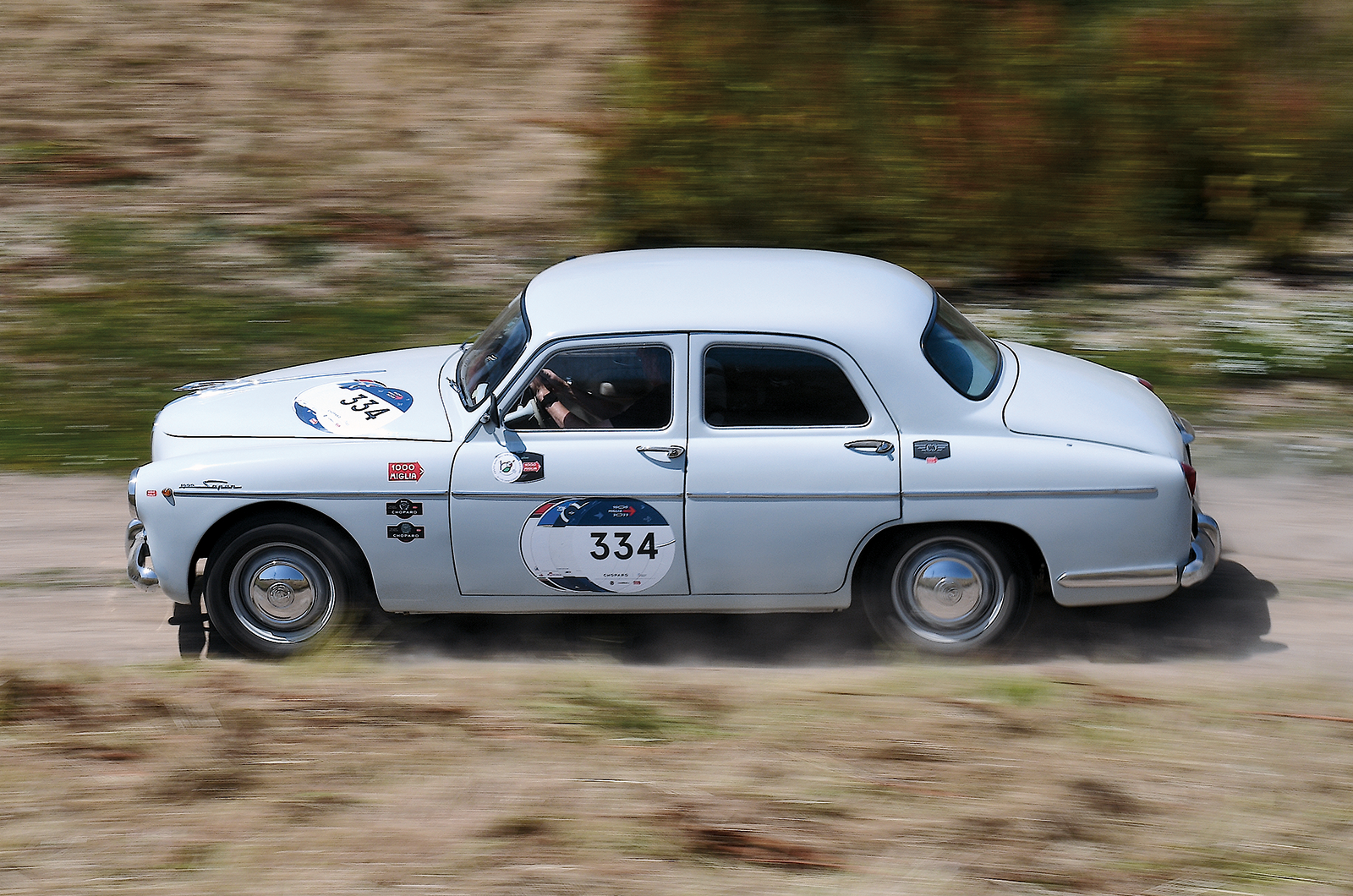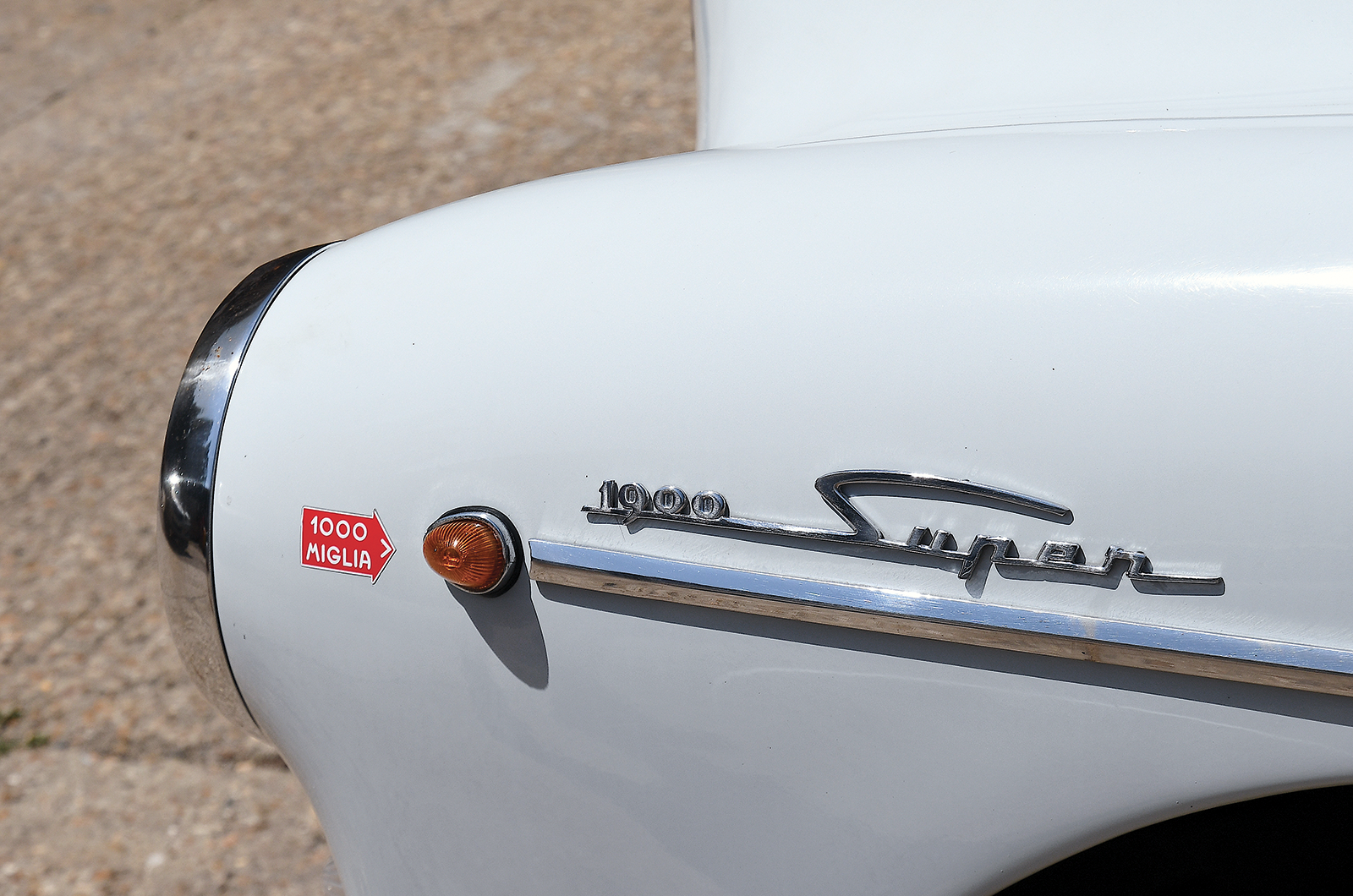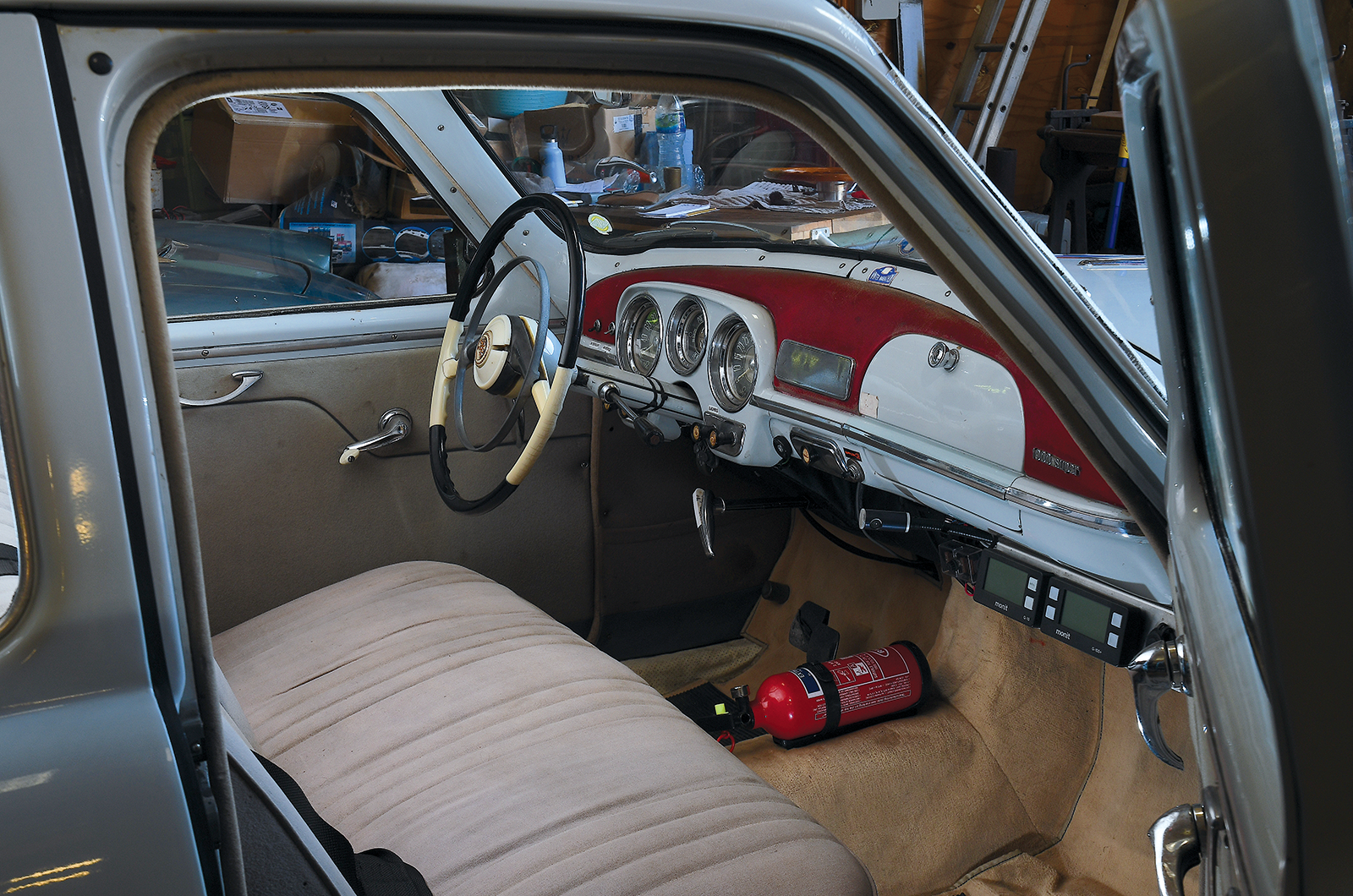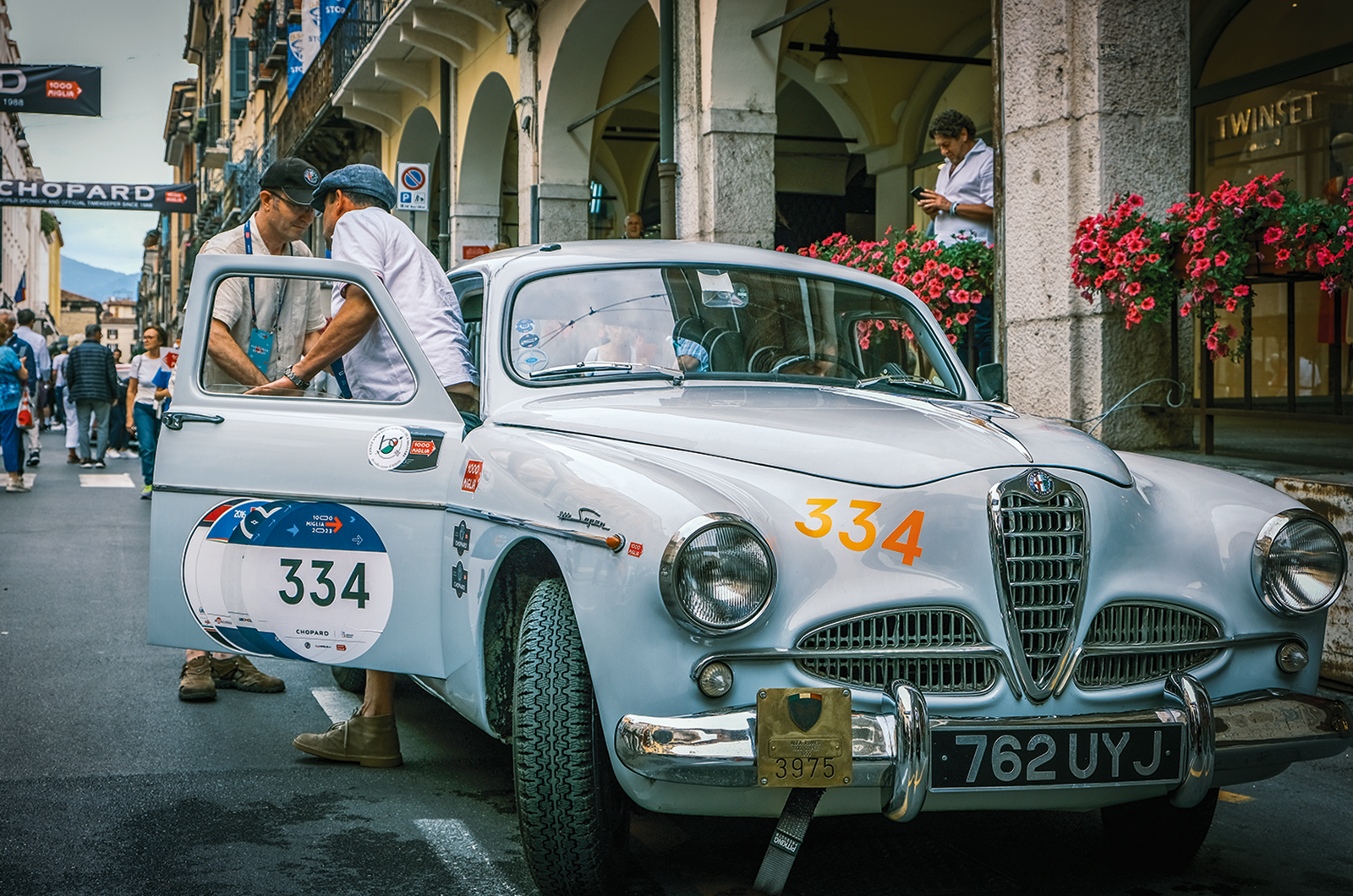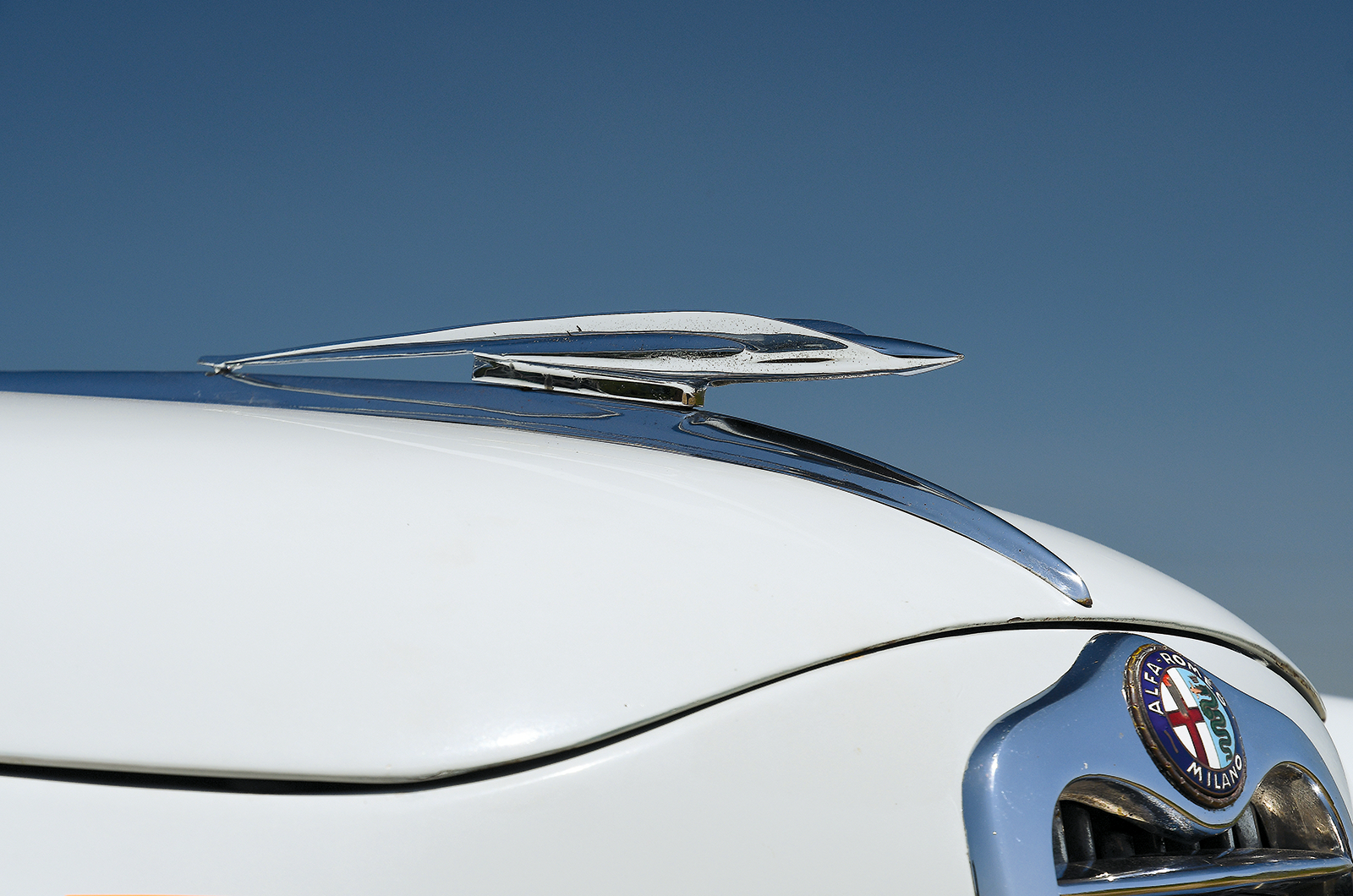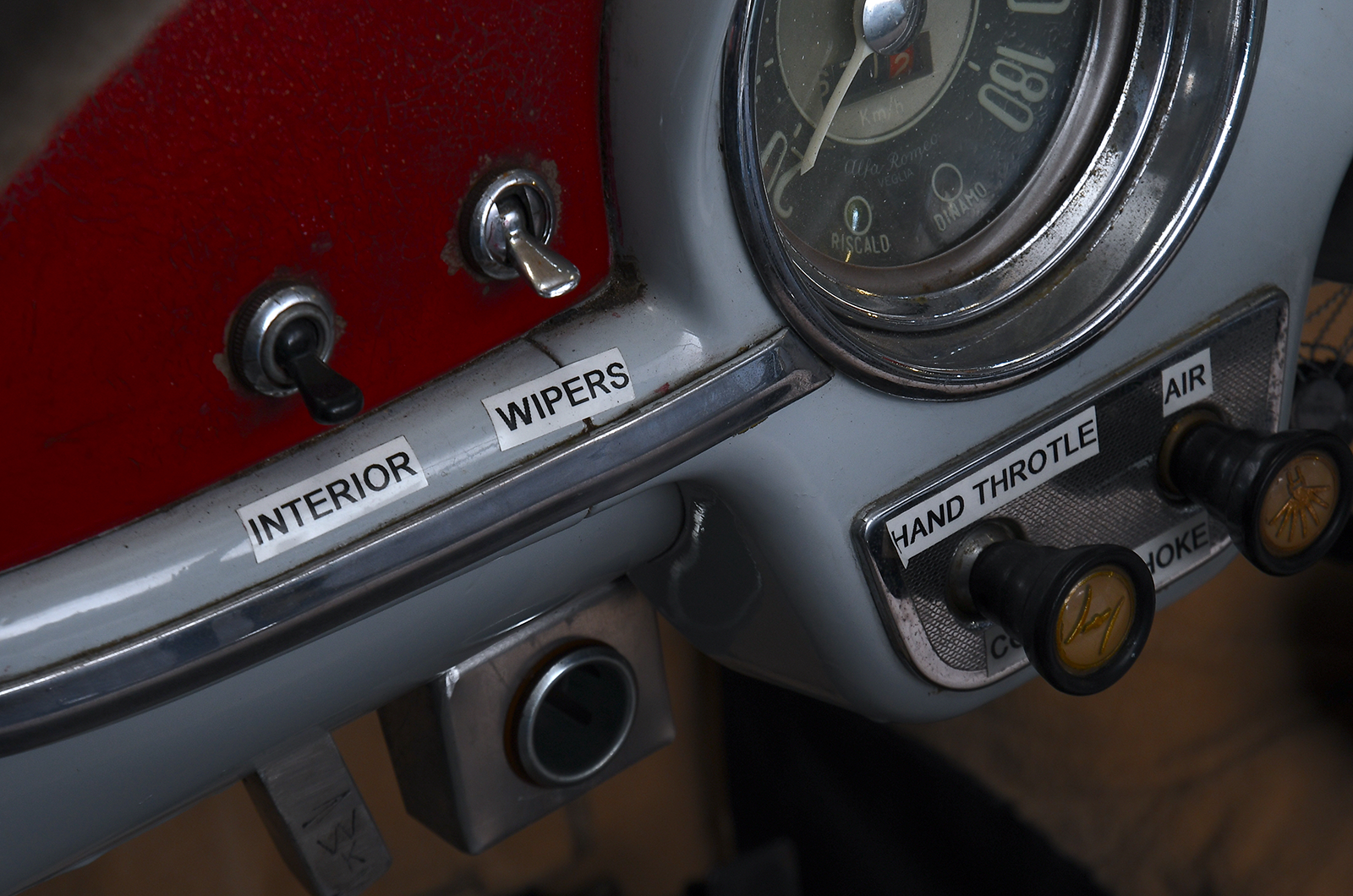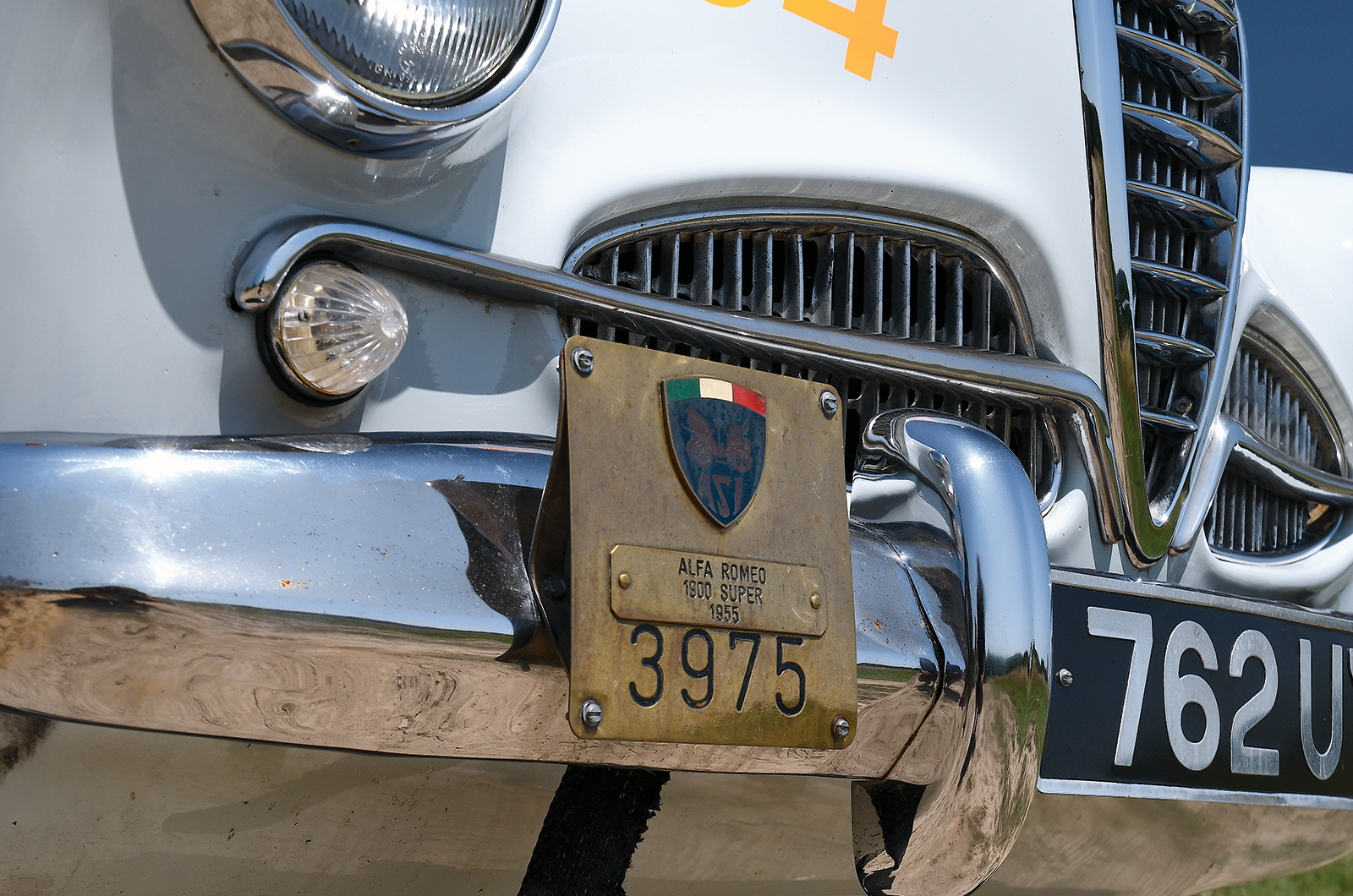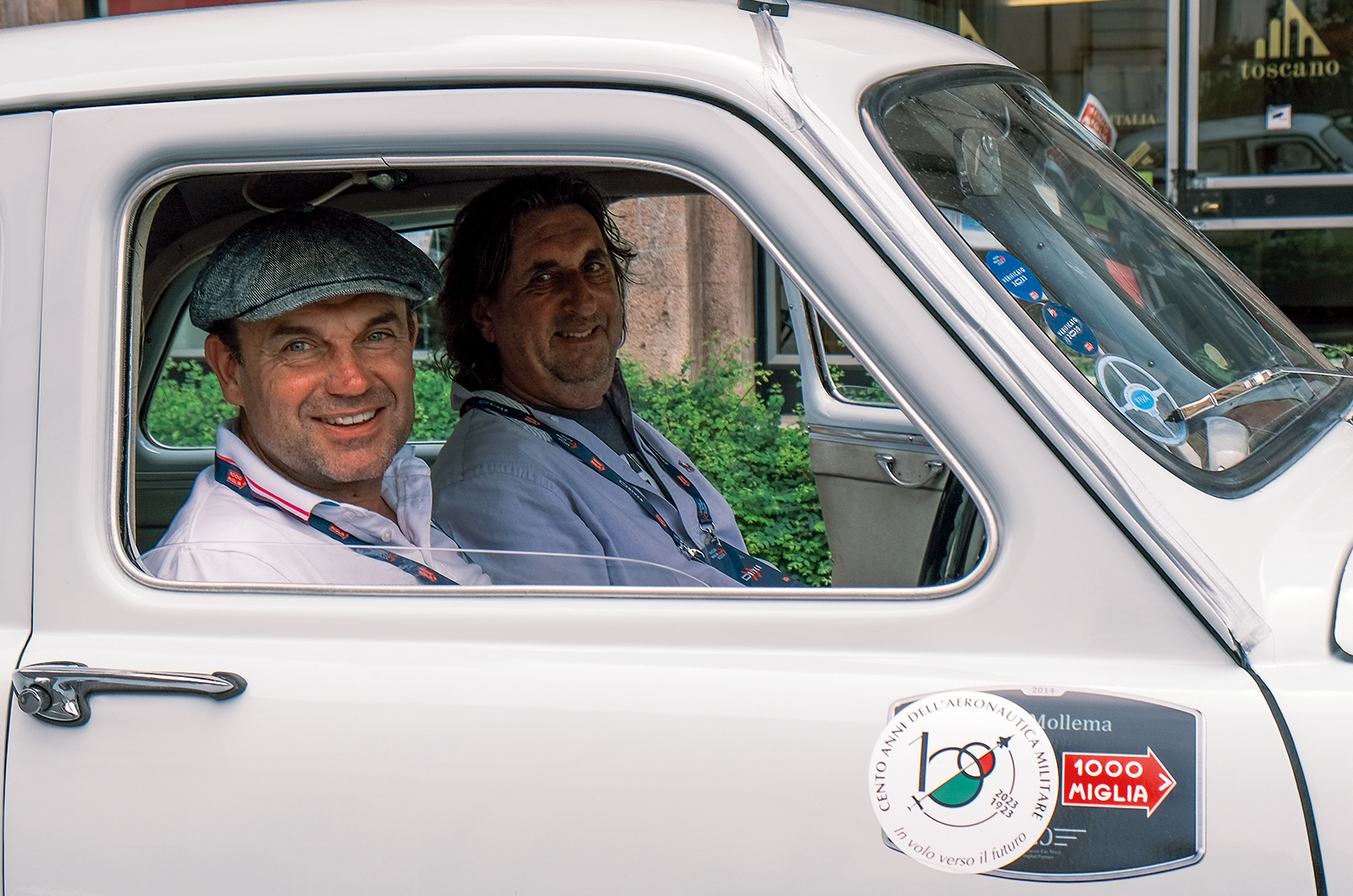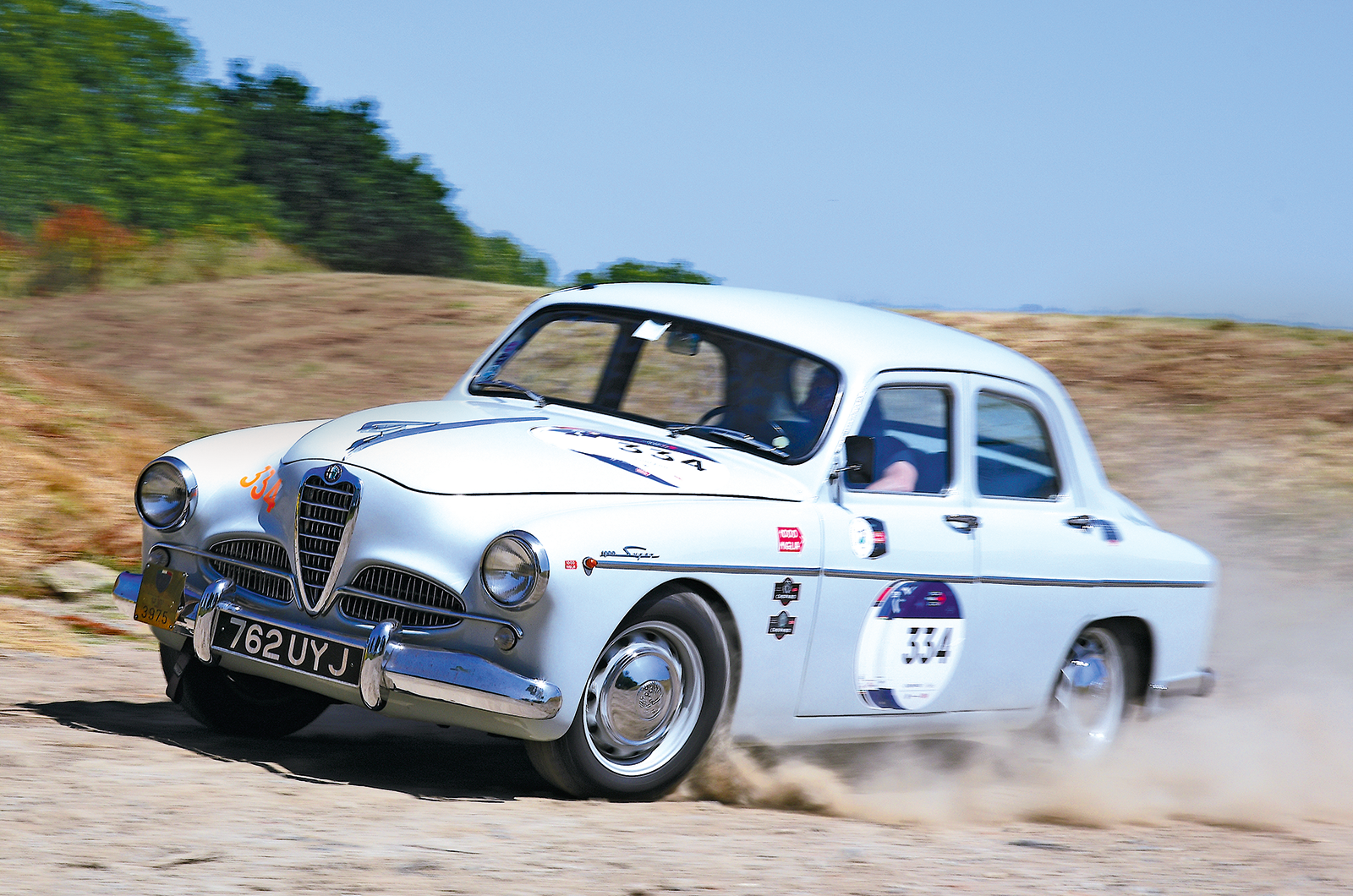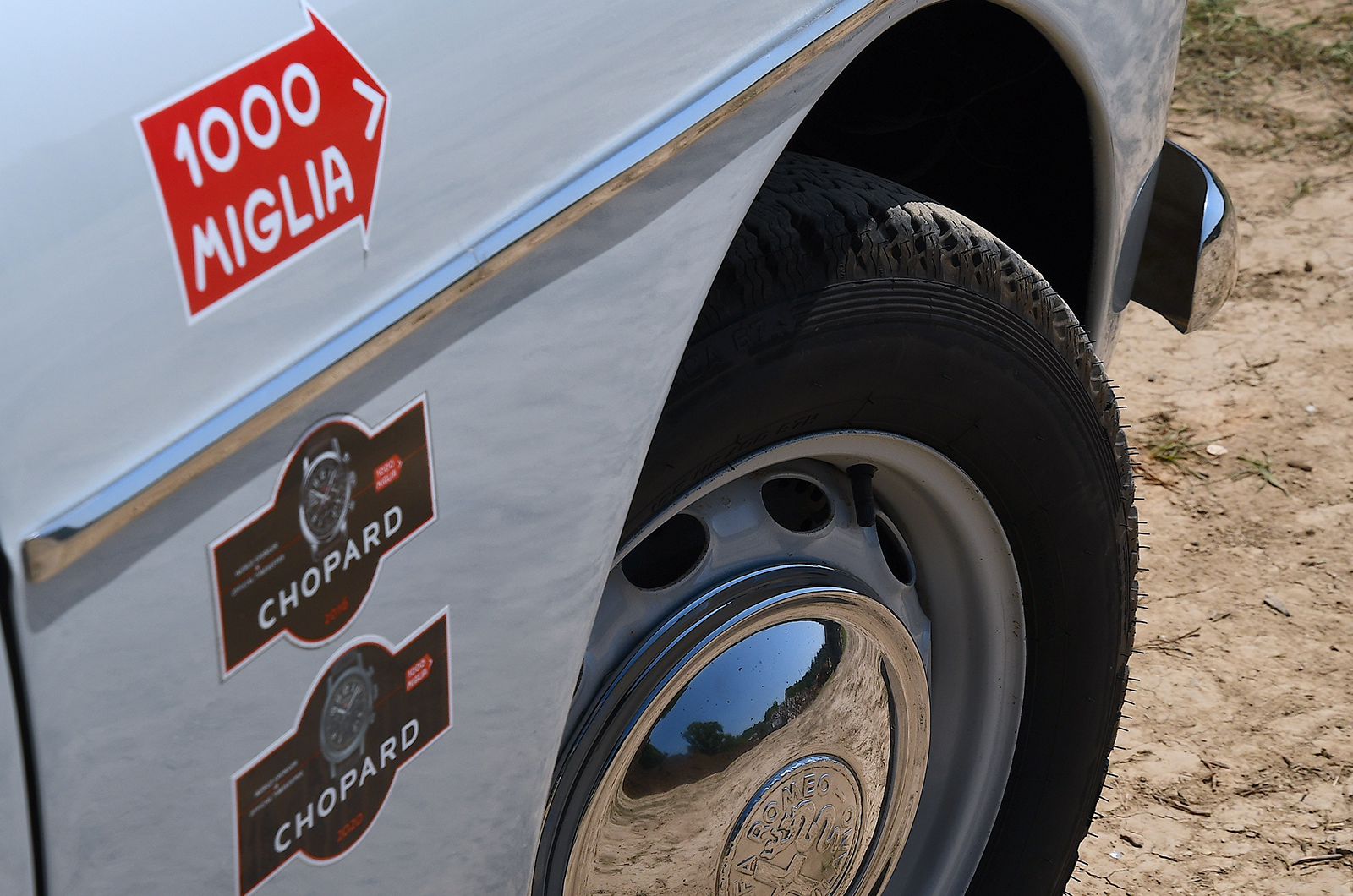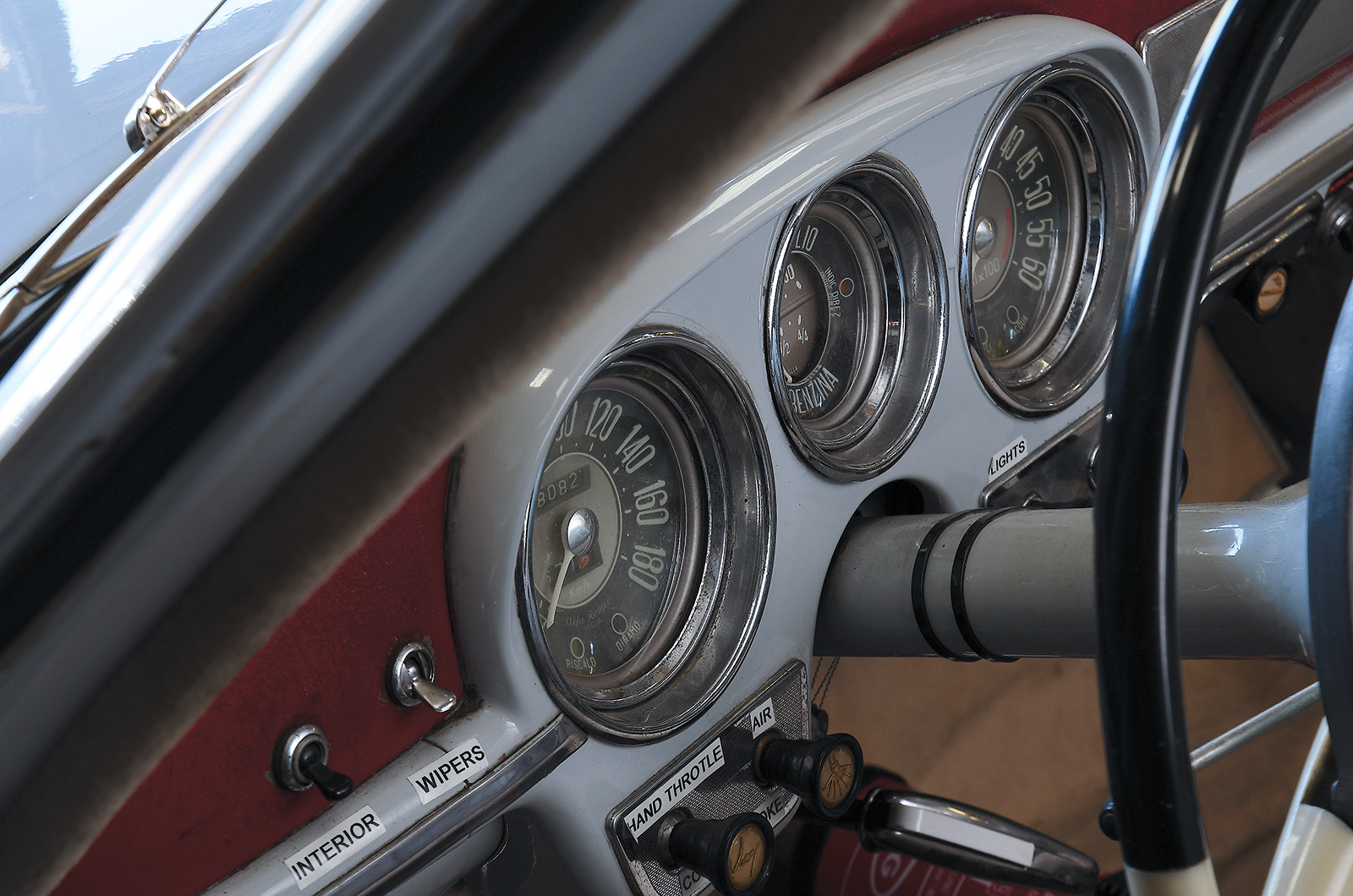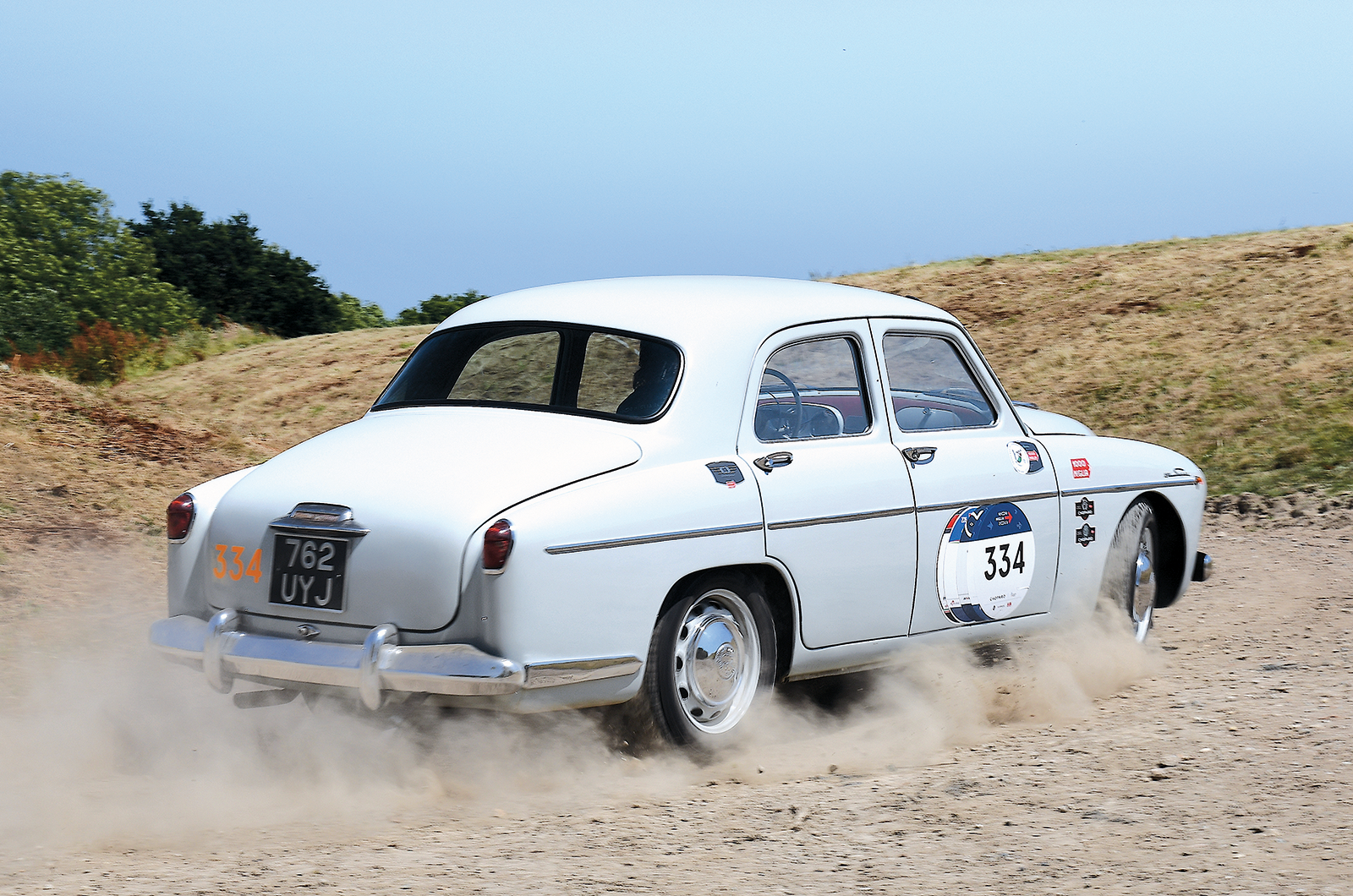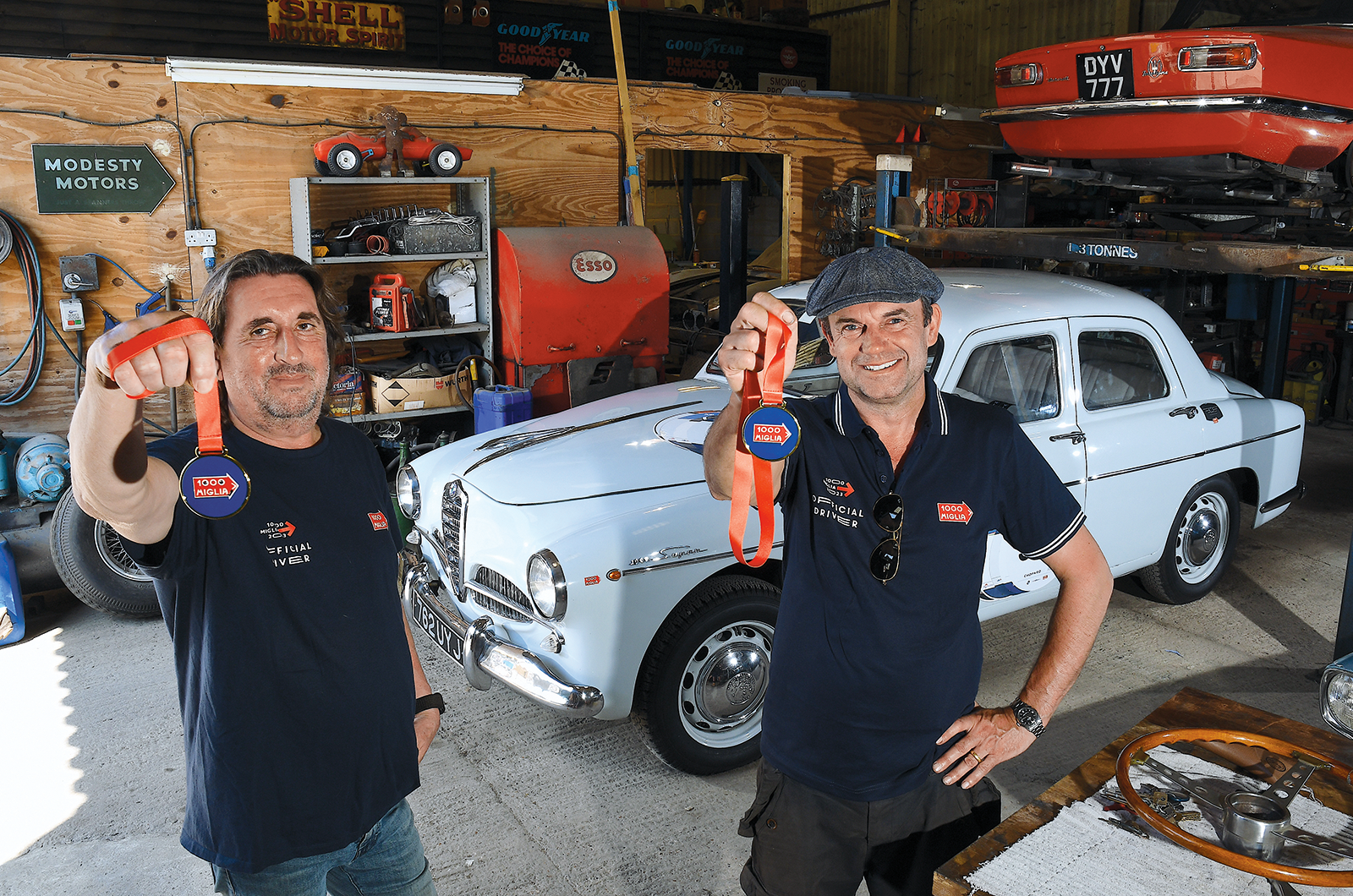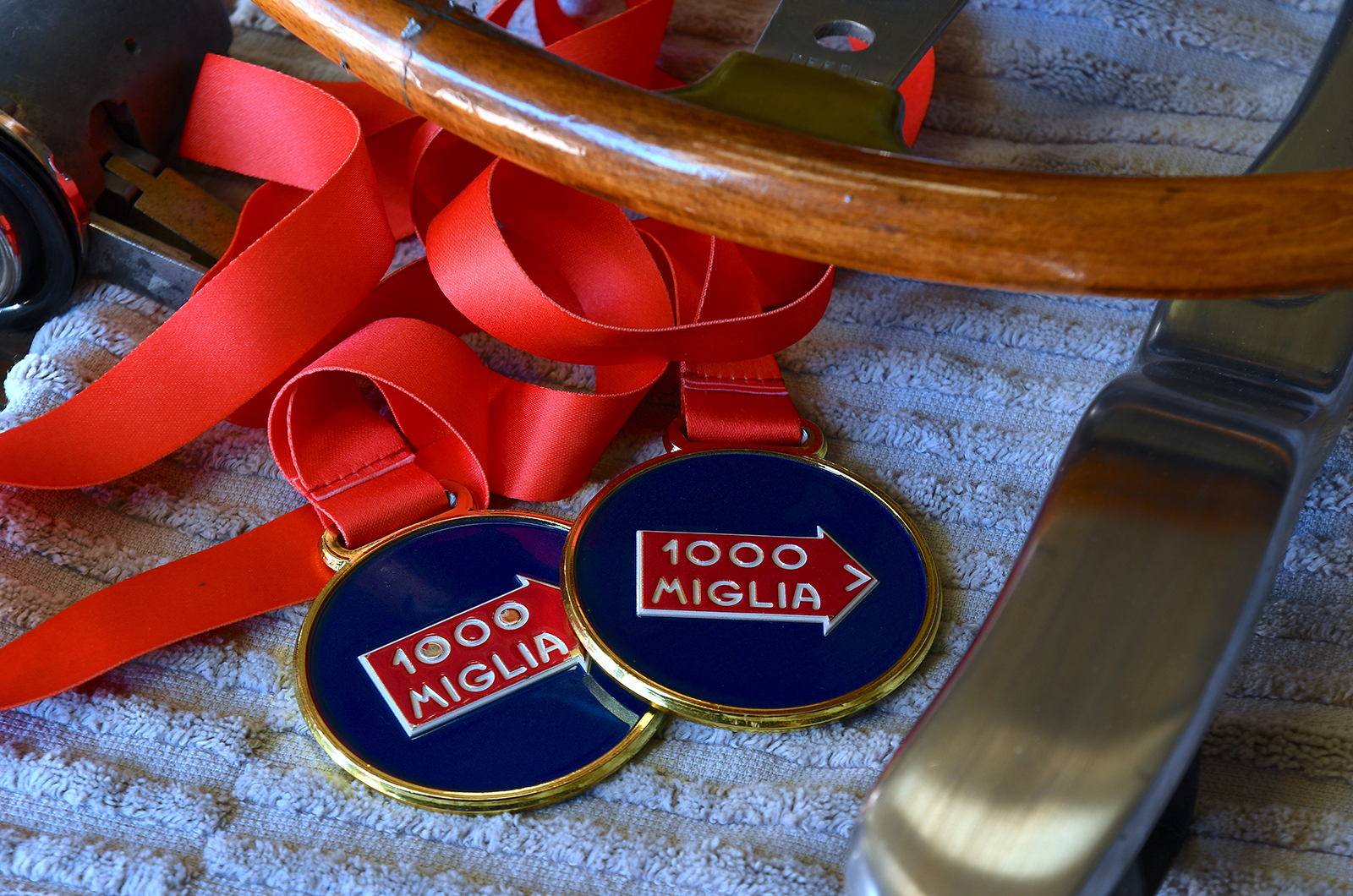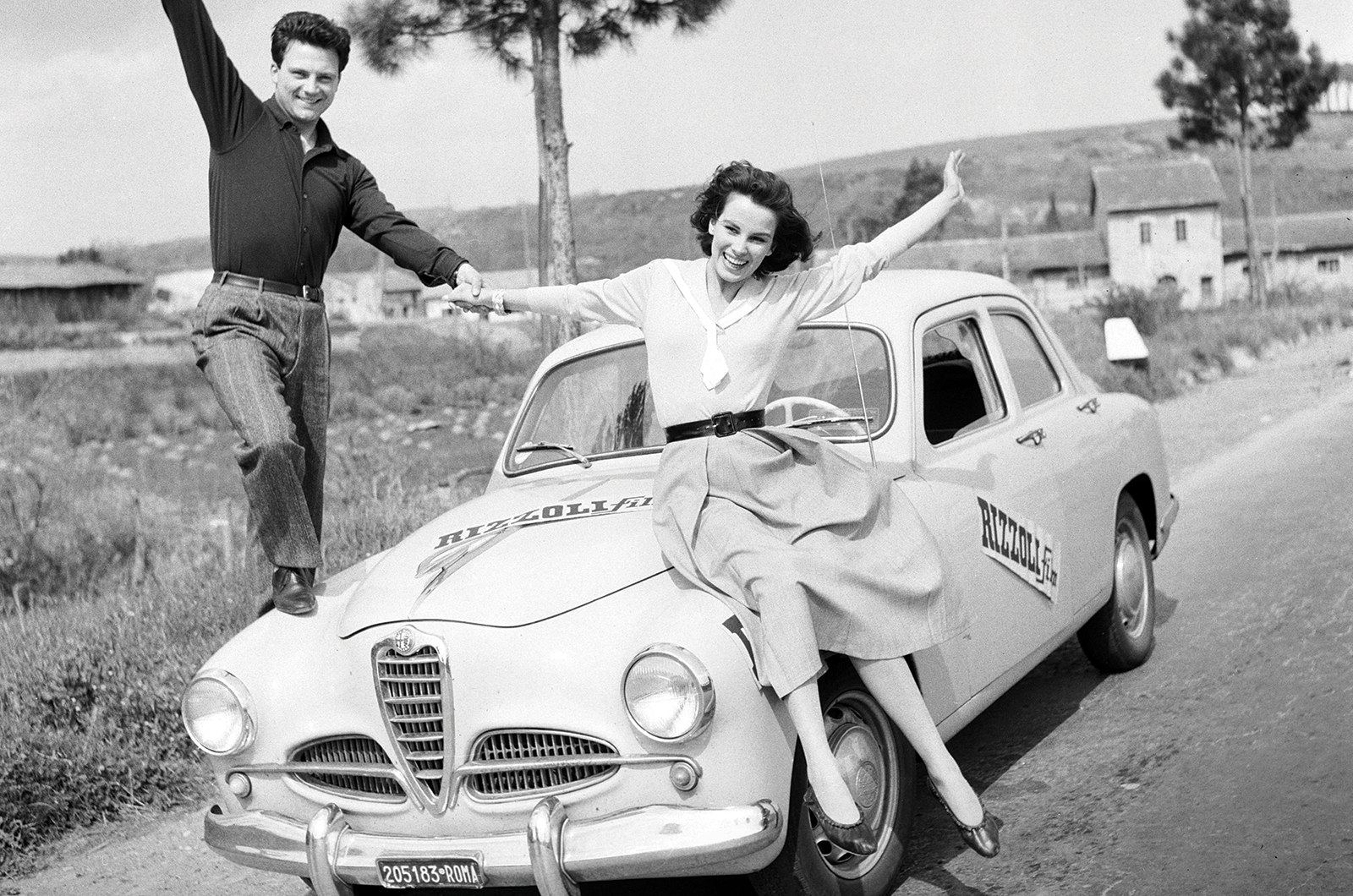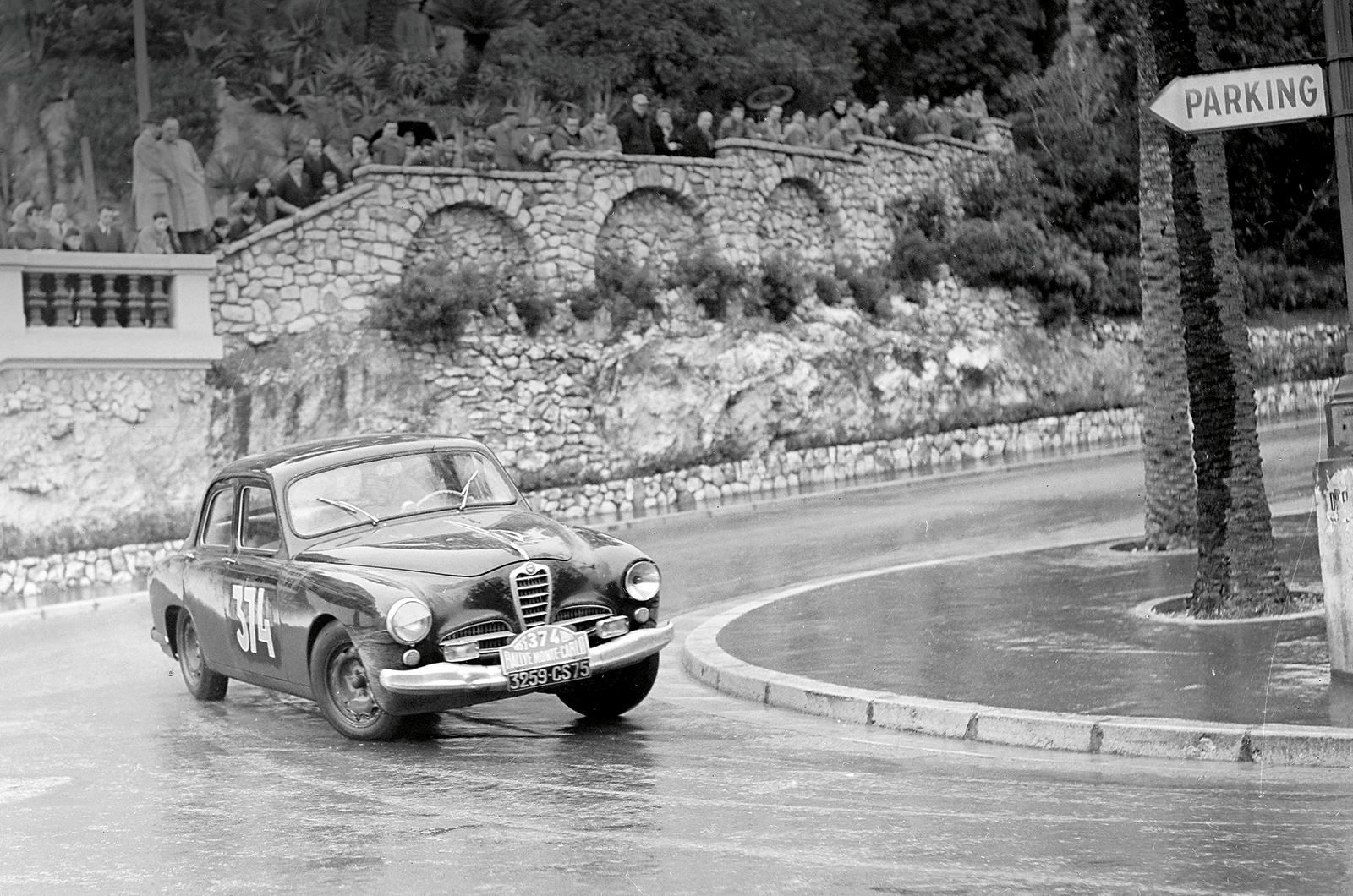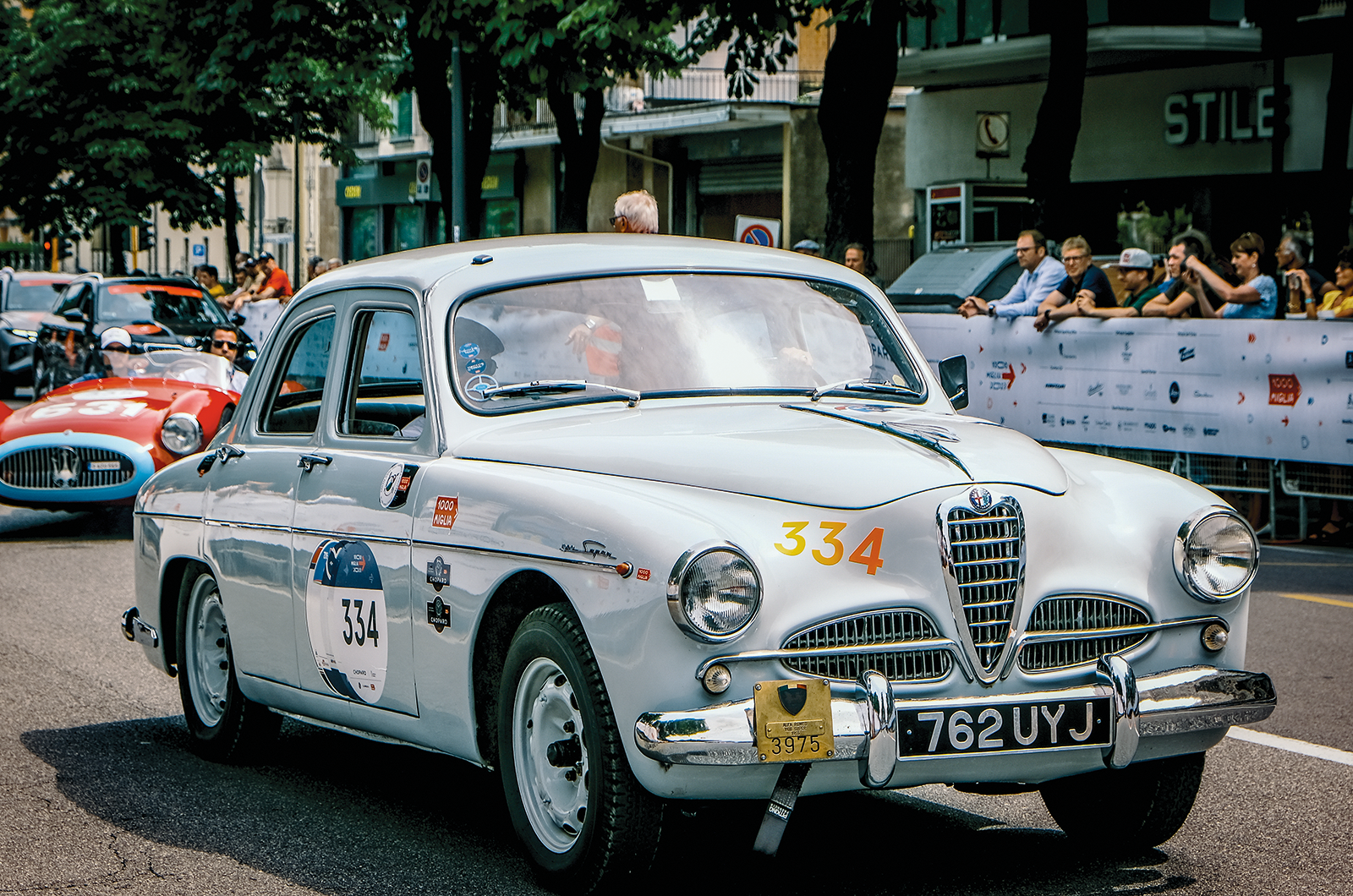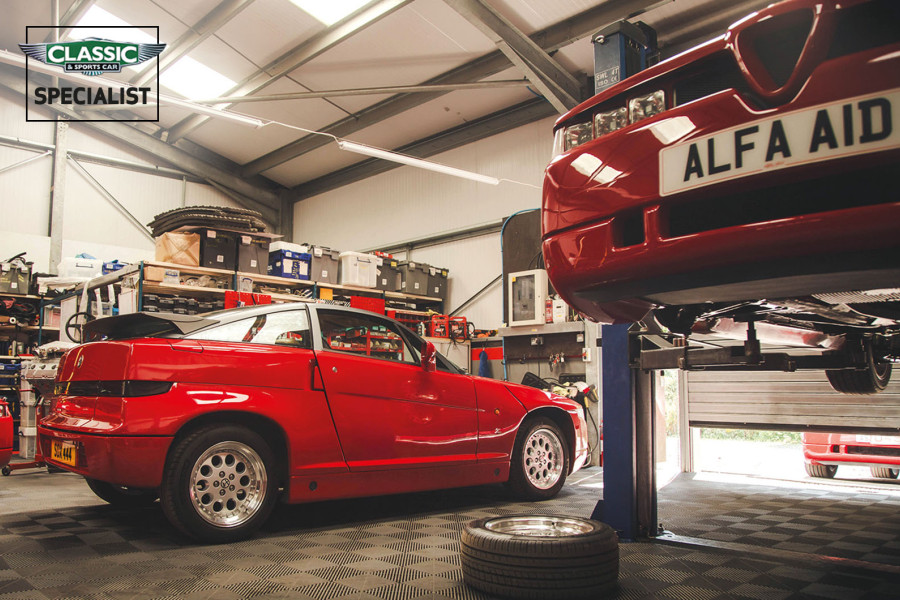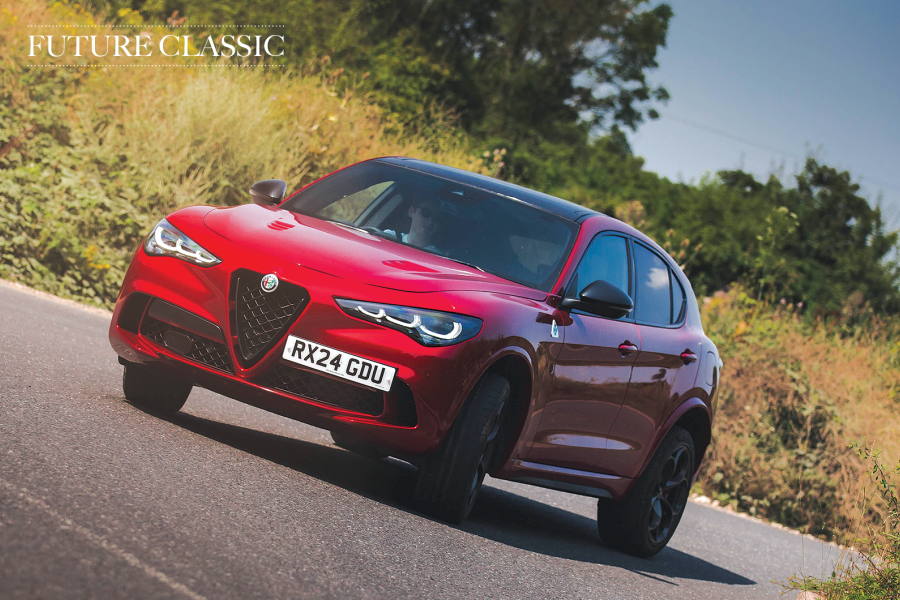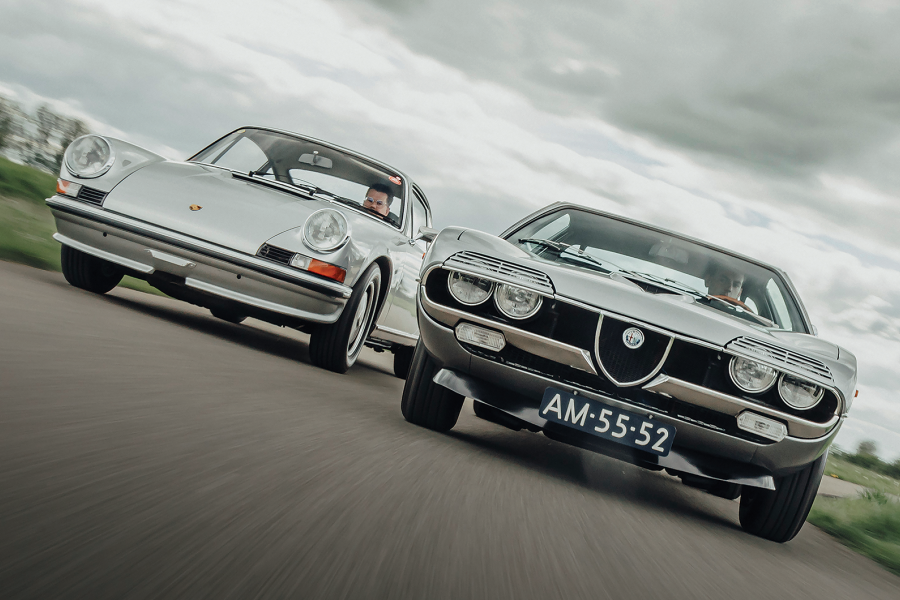Day two started at 7am, with a stop at San Marino for coffee then Senigallia for lunch.
Cooled by a desk fan wired into the Alfa’s electrics, Mark was starting to get to grips with the roadbook and the tripmeters: “The time trials were for low average speeds.
“Some people had 10 eggtimers on the dashboard for different sections; had we got the hang of that, we would have finished a lot higher.”
The Alfa Romeo 1900 Super’s well-stocked and stylish dashboard
Via Fermo and Ascoli Piceno, competitors emerged into Rome’s Via Veneto in the evening.
“I was so tired by that stage,” says Sheridan, “I don’t even remember seeing the Colosseum and, once we lost the police escort in traffic, we decided to head for our hotel.”
The Alfa was proving to be an excellent choice of car: “It was extremely comfortable; the roof was blessed shade and the airflow with the windows open was good. The cloth seats worked well from a heat point of view, too.”
“The Alfa stomped along – one guy in a Ferrari even commented on how quick it was”
Neither was the single-carburettor 1900 Super a slow car. “It stomped along – one guy in a Ferrari even commented on how quick it was,” says Sheridan, “and the brakes are good, although it did develop a pull to the right.”
Day three (Thursday) ended in Parma, but the highlight was lunch in Siena.
There was some quick motoring through open countryside and, as on the previous days, plenty of examples of risky overtaking manoeuvres by the quicker machinery.
Some 100 cars dropped out either through accidents or mechanical failure.
Sheridan (left) and Mark are rightly proud of the faithful Alfa Romeo 1900 Super’s performance on the Mille Miglia
Friday in Milan hosted the final evening of the event, after running through Stradalla, Pavia and into the Piedmont region for lunch at Alessandria.
Then Saturday and the finish line in Brescia beckoned, with the team coming a creditable 314th, ahead of 40 other cars.
“Just finishing was an achievement, given that I had never even read a tulip map,” smiles Mark.
Sheridan had fleeting thoughts of entering again, this time in a Healey, but has since thought better of it: “Having done it, and thoroughly enjoyed it, it would be impossible to improve on the experience, so why try?”
Mille Miglia medals are awarded upon crossing the finish line in Brescia, Italy
Given that it costs at least £16,000 just to enter the 1000 Miglia (and that is the basic package), it feels a bit of a stretch to say that Sheridan and Mark’s assault on the 2023 retrospective was a shoestring affair.
But all things are relative: when most – if not all – of your fellow entrants are flying in their seven-figure exotica by air freight (and jumping aboard private jets to get to Brescia), the team that takes two days to trailer its entry from England could be forgiven for feeling a bit of a poor relation.
Even if the tow car is a Maserati Levante.
Images: John Bradshaw/Joe Devanny www.devanny.co.uk
Alfa Romeo 1900: ‘The family car that wins races’
Alfa Romeo’s first series-production monocoque car was a more accessible, affordable saloon © Getty
Largely unknown in the UK, the 1950-’59 1900 skilfully combined modern features with Alfa tradition in a contemporary-looking 80bhp, 90mph five-seater family saloon.
It was designed to be built at the rate of 500 a month, and the concept was vindicated in the sales figures: 7600 cars in the first three years (more than the firm had produced in the entirety of the previous two decades) and a total of 17,390 units by the end of production.
Left-hand drive was new to Alfa and there hadn’t been a four-cylinder model for decades, although the 1900’s short-stroke twin-cam was very much in the mould of what Alfa had built in the ’30s, only more efficient and higher revving.
The 1884cc Normale was joined by the TI (Turismo Internationale) in 1951, with a twin-choke Weber that boosted output to 90bhp and took the top speed over 100mph.
Two years later came the 1975cc Super and twin-Solex TI Super, the latter a 115bhp/112mph car that was among the fastest four-door production saloons available; around the same time all types got a triangulated mounting bracket for the rear axle.
The 1900 Berlina earned a formidable reputation in the 2-litre production saloon class in the mid-’50s.
Having retired from Grand Prix racing, and despite the shift in focus to mass-market, volume-production models, Portello was keen to show it had not lost its taste for competition.
Madeleine Pochon and Marie Honore head for 16th place on the 1955 Rallye Monte-Carlo © Motorsport Images
If the acknowledged excellence of the 1900 put a positive spin on this populist move, its conspicuous success in classic events such as the Mille Miglia, Targa Florio and Carrera Panamericana only burnished its reputation.
Outside Italy they were found at closed-circuit events such as the Nürburgring 1000km (fourth in 1953), the Tour de France and the Alpine Rally.
The 1900’s potential for success in the hands of privateers was further boosted by the introduction of more powerful variants.
A TI Super won the Touring category in the 1954 Giro d’Italia, but the car’s potential had been proven a year earlier when no fewer than 40 1900s entered the 1953 Mille Miglia, resulting in podium-filling class wins.
On the 1954 Mille, 21 1900s finished – mostly saloons – resulting in another class victory and eighth overall.
A 1900 won the Giro di Sicilia outright in 1954, while a six-car assault on the ’54 Carrera resulted in a 15th overall and first in the 2-litre class.
With the arrival of the lighter, nimbler Giulietta, the 1900’s star began to fade, but it has always been a popular choice on the latter-day incarnation of the 1000 Miglia, with drivers and spectators alike.
Factfile
Alfa Romeo 1900 Super
- Sold/number built 1950-’59/17,390
- Construction steel monocoque
- Engine iron-block, alloy-head, dohc 1975cc ‘four’, Solex carburettor
- Max power 93bhp @ 5400rpm
- Max torque 96lb ft @ 3000rpm
- Transmission four-speed manual, RWD
- Suspension: front wishbones, upper link rear live axle, radius arms, triangulated link; coil springs, telescopic dampers f/r
- Steering worm and roller
- Brakes finned alloy drums
- Length 14ft 6in (4419mm)
- Width 5ft 3in (1600mm)
- Height 4ft 10in (1473mm)
- Wheelbase 8ft 7½in (2628mm)
- Weight 2578Ib (1169kg)
- Mpg 18-25
- 0-60mph 17.1 secs
- Top speed 102mph
- Price new £1300
- Price now £100,000-plus (if Mille Miglia-eligible)*
*Price correct at date of original publication
Enjoy more of the world’s best classic car content every month when you subscribe to C&SC – get our latest deals here
READ MORE
Alfa Romeo 1900 Super vs 2600 Berlina: a brave new world
Frazer Nash Mille Miglia: one size fits all
20 great saloon car classics
Martin Buckley
Senior Contributor, Classic & Sports Car
